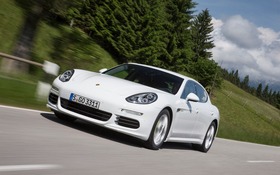2014 Porsche Panamera: Expanded Line-up

| Strong points |
|
|---|---|
| Weak points |
|
The Porsche Panamera has been made over for 2014 and is now available in more trim levels. This includes the Executive versions, whose wheelbase has been extended to win over ultra-rich Chinese clients who prefer being driven over actually driving. Next, there’s the brand new E-Hybrid, which becomes the world’s first rechargeable luxury hybrid car and whose number one objective is to reduce CO2 emissions to the bare minimum. To this end, the Panamera S and 4S engines have been replaced by a 3.0-litre V6 twin-turbo that develops 420 horsepower – 20 more than the V8 that previously powered these versions. This is the evolution of the Panamera.
Introduced at the Shanghai Auto Show, the restyled Panamera is distinguished by new headlights with repositioned daytime running lights and by its front shield with larger lateral air intakes. In back, the window is slightly more inclined and larger than before. The new tail light design helps accentuate the car’s width. Plus, the Panamera now comes with a factory-standard automatic liftgate and, the new Executive trim’s wheelbase is 15 centimetres longer to provide increased legroom for back-seat passengers. The new generation’s look is a subtle evolution rather than the revolution suggested by the superb Porsche Panamera Sport Turismo Wagon Concept, unveiled at the Paris World Auto Show in September 2012.
- Also: Porsche Tease its Future
- Also: Porsche Panamera Exclusive Series: For Someone who has Everything
A partial trend toward downsizing
Driving the Panamera 4S on German highways and secondary roads, we didn’t miss the V8 engine at all since the twin-turbo V6 offers more power and more direct torque. Oh, and its fuel consumption has been improved to the tune of 18 percent, which means you can have your cake and eat it too. This is not to say that the Panamera’s 8-cylinder engines are gone: you can still get the GTS with the 4.8-litre naturally-aspirated V8 developing 440 horsepower. Its evocative sound is in keeping with the vehicle’s classic purpose. What’s more, the Turbo and Turbo S models are still equipped with outrageously powerful twin-turbo engines that produce 520 and 560 horsepower, respectively. Of these three trims, the GTS is the best choice for performance enthusiasts. It owes its more incisive nature to the fact that there is no lag whatsoever when you press the accelerator. Taking full advantage of the Turbo and Turbo S versions’ enormous performance potential is difficult on Canadian roads, so when people decide to buy one here, it’s more about showing off one of the most powerful and expensive cars on the road than anything else.
Saving the planet, one Panamera at a time
The main event of the 2014 vintage is without of a doubt the arrival of the Panamera S E-Hybrid, which is powered by the 3.0-litre V6 with a supercharger borrowed from Audi and then paired with a 95-horsepower electric motor. The combined 416 horsepower is directed to the rear wheels by way of an eight-speed TipTronic automatic gearbox. A veritable technical tour de force, this drivetrain is explained in detail by Denis Duquet in the “Technology” file in this section of The Car Guide. I drove the Panamera S E-Hybrid on an 87.1 kilometre circuit in which the average fuel consumption was 5.8 litres per 100 kilometres due to the fact that 53.9 of these kilometres were travelled exclusively on electric power. I should note that the first part of this circuit was designed specifically to reduce energy consumption – electric and hydrocarbon alike. Thus, the first 50 kilometres of the course were on a slight downhill. Nevertheless, it is completely conceivable to travel between 18 and 36 kilometres exclusively on electric power in normal driving conditions. With a full charge in the 9.4 kWh battery, the S E-Hybrid starts in electric mode, known as E-Power, by default, but the driver can also choose three other modes: there’s Hybrid mode that preserves the battery charge for later use, E-Charge mode that helps recharge the battery while the car operates using the combustion engine, and Sport mode that takes full advantage the two energy sources thus ensuring a 0-100 km/h time of 5.5 seconds. That means the S E-Hybrid takes a half-second more than the 4S over this distance, but that is easily explained by the hybrid’s 2,095 kilos, some 225 more than the 4S and 325 more than the base version, making it the heaviest in the line-up. This extra weight also has a direct impact on the S E-Hybrid’s handling, which is not as dynamic as the other versions of the Panamera.
With such a wide array of choices, the Panamera sets the bar a little higher with the addition of its rechargeable hybrid version. It won’t be long before the competition responds, as Mercedes-Benz will unveil a rechargeable hybrid version of its new S-Class at the Frankfurt Auto Show in September 2013.











